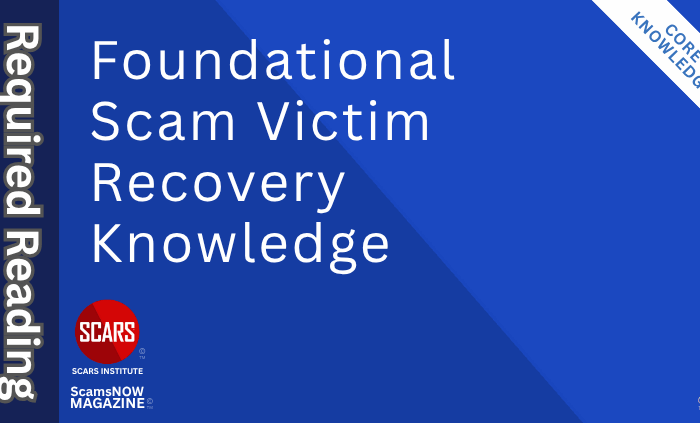
Let Your Emotions Flow – Name It – Don’t Shame It or Blame It
Emotions are Not the Enemy. Learn to Understand Them by Naming Them
Primary Category: Scam Victim Recovery Psychology
Authors:
• Tim McGuinness, Ph.D., DFin, MCPO, MAnth – Anthropologist, Scientist, Polymath, Director of the Society of Citizens Against Relationship Scams Inc.
Author Biographies Below
About This Article
After a relationship scam, emotions and attention often turn inward in ways that keep pain active. Shame-driven self-focus attacks your worth, rumination replays events without resolution, and the body stays on alert. Relief grows when emotions get named, the body calms through longer exhales and brief movement, and judgment shifts to clear description. Sorting by time, topic, and evidence organizes facts and feelings, while short, direct statements protect energy and improve support. Healthy anger and grief receive a safe, limited space, then attention returns to small actions that match values. Limits on exposure, morning light, regular meals, and a simple evening wind-down help reset the nervous system. A therapist trained in betrayal trauma may add structure and pace. Progress shows up as steadier sleep, fewer sweeping claims, and a pause before decisions. Emotions remain present, yet they stop leading. Recovery becomes a series of calm, repeatable steps.
Note: This article is intended for informational purposes and does not replace professional medical advice. If you are experiencing distress, please consult a qualified mental health professional.

Emotions are Not the Enemy. Learn to Understand Them by Naming Them
After a relationship scam, your emotions and attention often turns inward in ways that keep pain active.
Shame-driven self-focus and circular rumination take over, and the body stays on alert. Ordinary tasks feel heavy, sleep breaks, and conversations strain under doubt and second-guessing. The mind keeps asking how this happened, while the nervous system reacts as if danger is still present.
The core problem involves two unhelpful forms of self-awareness. Shame-driven self-focus attacks your worth with harsh labels, blames the self for being deceived, and treats every memory as proof of failure. Rumination replays events without resolution, searches for a perfect answer that never appears, and drains energy from care, work, and rest. Both patterns pull attention away from the present, increase risk, and delay support.
A different stance can help. Reflective self-awareness notices thoughts, feelings, and body signals in real time, uses descriptive language instead of judgment, and returns attention to the next small step. This approach supports steady boundaries, clearer speech, safer decisions, and kinder self-respect. The goal is not to erase strong emotion. The goal is to hold emotion in a way that protects health, maintains dignity, and opens space for action.
Your recovery can begin when attention shifts from self-attack and replay toward observation, naming, and purposeful action. With consistent practice, the body settles, facts organize, requests for help become clear, and daily life starts to feel possible again.
Name the Emotion, then Pause
When an emotional wave hits, quietly label the emotional state: “shame-voice,” “sadness,” “anguish,” “rumination,” or “clear view.” Naming the emotional mode lowers the intensity and can reduce the duration. After naming it, pause for deep three breaths, with longer exhales than inhales. This short pause creates room to choose the next move.
Ground the Body First
Safety signals calm the alarm system. Sit with both feet on the floor, relax the jaw, drop the shoulders, and breathe out slowly for a ten count. Look around the room and name three neutral objects. A calmer body makes clearer thinking possible.
Switch from Judgment to Description
Shame-voice uses global labels such as “I am stupid.” Replace these negative labels with descriptions that fit the moment: “I was deceived by a criminal,” “a transfer happened on Monday,” “strong grief shows up today.” Description reduces the negative emotions and preserves dignity.
Sort by Time, Topic, and Evidence
Your rumination blends everything all at once. Use a small notebook or journal with three headings: “before,” “during,” and “after,” for each strong emotion or trigger you feel each day. Under each, write three short items: “what happened,” “what I feel,” “what action may help next time.” Add a brief evidence check with three questions: “What do I know,” “what do I think,” “what do I fear.” This structure turns spinning thoughts into analytical sorting.
Use Short, Direct Statements
Prepare two or three statements that protect your energy and invite support from yourself or others, for example: “I can talk for ten minutes, then I need a break,” “Please help me list the dates and amounts,” “I will not accept insults.” Practicing your words helps reduce relapse into shame or spirals.
Limit Exposure, Increase Rhythm
Set simple guardrails that lower your nervous-system load. Delay replies to unknown contacts, so you have time to think and decide if they are a threat or harmless. Keep a consistent wake time, sit outside in the morning light, eat regular meals, take a brief post-stress walk, and enjoy a deliberate or intentional short evening wind-down. Predictable rhythm teaches your body that safety returns.
Give Anger and Grief a Safe Place
Healthy anger and grief carry important information. You should schedule short, contained windows to feel and express them. Say, “anger is information,” or “grief belongs here.” After ten minutes, close the window with a breath and a small intentional action like drinking water, stretching, or a short walk outside.
Replace Global Beliefs with Simple Tests
When your shame-voice says, “no one can be trusted.” Create small, testable steps for yourself: verify one claim that you made, research to find the real answer, or ask a second reliable safe source. This rebuilds judgment without forcing blind trust.
Use Attention & Intention on Purpose
You can choose one object of focus at a time. For example, for three minutes, feel your feet on the ground, or follow your breath, or wash a cup slowly and notice your senses. Purposeful attention with intention builds the mental muscle of staying in the present without slipping into analysis loops.
Track Signals, Not Perfection
Once a day, try to note three items: “body signals,” “triggers,” “useful responses.” For example: “my jaw was tight,” “I got a call from an unknown number,” “I did three long exhales and stood up.” Tracking teaches the brain that responses exist and work.
Invite Steady Support
Ask one trusted person for specific help: “please listen to me for five minutes,” “please help me practice my statements,” “please walk with me after hard calls.” Clear requests lead to useful support and reduces isolation.
Work with a Certified Trauma-Informed Therapist
A therapist trained in betrayal trauma and dissolution can guide your short reviews, your grounding skills, and your belief updates. Therapy styles that often help include cognitive behavioral therapy, acceptance and commitment therapy, EMDR, and skills from dialectical behavior therapy. Your aim is a calmer body, clearer memory, and kinder self-talk.
A Three-Part Daily Practice (Five to Ten Minutes Total)
-
- Morning: light, water, and one descriptive sentence in a notebook or journal.
- Midday: two minutes of slow exhale, then one practical step that matches values.
- Evening: lower light, a brief reflection using the three questions, and one kind phrase such as “I am learning,” or “this will pass.”
Learn the Markers of Your Progress
Shifts often sound like “sometimes” instead of “always,” and “this person” instead of “everyone.” Listen carefully to the words you use, even think.
Sleep steadies your mind and body, decisions slow to a safer pace, and a pause can happen before action. These signs point to reflective self-awareness taking the lead.
These transition rests on small, repeatable moves. Name the emotion, calm the body, describe what you feel rather than judge, analyze rather than spin, and speak with clear, brief statements. With practice, your attention turns from self-attack and endless loops toward present-tense awareness that holds truth, protects your dignity, and supports your recovery.
Conclusion
Recovery asks you for steady, honest effort, not perfection. Your emotions carry signals, not verdicts, and can be worked with rather than feared.
When shame-driven self-focus or rumination rises, give it a name, pause for three slow breaths with longer exhales, soften the jaw, relax the shoulders, and take a brief walk. Description defeats judgment. Short, direct statements that match the moment protect your dignity, guide your actions, and invite useful support.
Practice rebuilds your trust in the present. Analyzing by time, topic, and evidence organizes your facts and feelings, while clear, concrete words keep internal and external conversations from drifting into confusion. Healthy anger and grief deserve a safe, brief place each day, then your attention should return to small actions that match your values. Put limits on negative exposure, rejoice in the morning light, eat regular meals, and enjoy a simple evening wind-down that helps your nervous system relearn safety and rest.
Remember, progress often arrives quietly. Sleep steadies, sweeping claims soften into specific observations, and a pause appears before decisions. Self-respect grows as your language becomes kinder, and the body answers with lower alarm. Emotions remain part of your life, yet they stop running the day. A calm breath, a named feeling, and a clear statement redirect a difficult moment toward choice and care.
Support matters across this work. A therapist trained in betrayal trauma and dissonance can help pace your process, refine your skills, and reduce setbacks. Trusted people can listen to you for a few minutes, help list dates and amounts, and walk along after challenging moments. Each small, repeatable step reinforces the message that safety returns, that dignity holds, and that meaning can be rebuilt.
Strong feelings and steady action can live side by side. With patient practice, consistent routines, and good company, your life begins to warm again, and days can hold both truth and relief, one clear choice at a time.

Glossary
- Acceptance and Commitment Therapy (ACT) — A skills-based therapy that teaches acceptance of difficult thoughts and feelings while committing to actions that match values. In this approach, you practice mindfulness, clarify what matters, and take small steps even when strong emotion remains. The aim is steadier behavior, not the removal of feelings.
- Adrenaline — A stress hormone that prepares the body for action. After a scam, spikes may show up as a racing heart, tight muscles, or restlessness. Short walks and longer exhales can help the surge pass.
- After Episode — The period following exposure of the scam when new routines and supports take shape. In this episode, you build structure, set limits, and make brief plans that match today’s needs. Treat it as a distinct phase so progress is easier to see.
- Anger, Healthy — A signal that a boundary was crossed. When named and expressed safely, it guides clear limits and short, useful actions. Safe expression tends to lower physical tension and reduce rumination.
- Attachment — The bond system that tracks safety, closeness, and loss. After betrayal, push-pull feelings are common, with part of you seeking contact and part seeking distance. Simple routines and clear limits help this system settle.
- Attention and Intention — A paired practice of choosing one focus and one purpose at a time. For a few minutes, you place attention on a simple task and intend only to complete that step. This builds present-tense stability.
- Body-First Tools — Small actions that calm physiology so thinking can clear. Examples include slow breathing with longer exhales, gentle stretching, light movement, and warm showers. A steadier body supports steadier decisions.
- Boundaries, Clear — Brief, firm limits that protect time, energy, and safety. Phrases like “I will pause this call if shouting starts” signal what will happen next. Follow-through teaches the body that protection exists.
- Breathing with Longer Exhale — A calming pattern that engages the body’s settling response. Inhale through the nose, then exhale through the mouth for a longer count. Two minutes can lower heart rate and reduce alarm.
- Circadian Rhythm — The body’s daily clock that shapes sleep and mood. Morning light and consistent wake times help reset this rhythm after stressful nights. A predictable rhythm reduces reactivity.
- Clear Statements — Short, specific sentences that match the moment. Examples include “I can talk for ten minutes,” or “Please help me list dates and amounts.” Clear wording invites useful help and reduces confusion.
- Cognitive Dissonance — The mental strain of holding clashing truths, such as caring feelings and harmful behavior. After exposure, this clash can spike and drive review of messages or doubts about judgment. Simple facts and time-bound reviews help the strain ease.
- Cluster Thinking — The habit of bundling many thoughts and feelings into one lump. Under stress, this blurs differences between facts, fears, and guesses. Sorting by time, topic, and evidence reduces the blur.
- Cortisol — A stress hormone involved in energy and inflammation. Long periods of worry may keep levels elevated, which can affect sleep, mood, and immunity. Calming routines and regular meals support balance.
- Daily Practice (Three-Part) — A brief morning-midday-evening routine that steadies the day. Morning adds light and water with one descriptive sentence; midday adds slow exhales and one practical step; evening adds lower light and a short reflection. Consistency matters more than length.
- Descriptive Language — Words that describe events without harsh judgment. Statements like “a transfer happened on Monday” or “grief is strong today” preserve dignity and reduce shame. Description opens space for choice.
- Dopamine — A brain chemical tied to reward and anticipation. Scammers often manipulate this system with frequent contacts and promises. Distance, structure, and new habits help the system relearn safer rhythms.
- Evidence Check — A quick sort using three questions: “What do I know, what do I think, what do I fear.” Writing one sentence for each lowers emotional noise and clarifies next steps. This turns spinning into sorting.
- Evening Wind-Down — A short, repeated routine that signals rest. Lower light, calmer media, and the same two or three steps help sleep return. Better sleep improves judgment and pain tolerance.
- Exposure Limits — Simple guardrails that lower nervous-system load. Examples include delaying replies to unknown contacts and capping news or scam content at set times. Less exposure reduces triggers.
- Focused Help Requests — One-sentence asks that guide support. Examples include “Please listen for five minutes,” or “Please review my timeline for gaps.” Specific requests save time and energy.
- Grounding — A set of actions that orient attention to the present. Sitting with both feet on the floor, relaxing the jaw, and naming three neutral objects can steady the body. A grounded body allows clearer speech.
- Grief Rituals — Small, repeatable acts that give grief a safe place. A morning sentence like “I cared, I tried, I learned,” or placing a small object on a shelf can hold emotion without flooding the day. Rituals honor feeling while protecting function.
- High-Alert Physiology — The body state that lingers after threat, marked by tightness, startle, and fast thoughts. Gentle movement, slow breathing, and predictable routines teach the system that safety returns. Over time, alarms fire less often.
- Intrusive Memories — Unwanted images or thoughts that pop in without invitation. Short acknowledgments, a breath, and a return to the present task help them pass. Keeping notes for care visits turns episodes into usable information.
- Journal or Notebook — A simple tool for sorting facts, feelings, and actions. Pages labeled “before,” “during,” and “after” reduce mixing and support clear reports. Brief entries are enough.
- Kind Self-Talk — Calm phrases that lower shame and steady action. Examples include “This is hard, and learning continues,” or “Anger is information.” Kind words protect dignity and reduce relapse into rumination.
- Light in the Morning — Natural light soon after waking that resets internal clocks. A few minutes outside can improve mood the same day and sleep the same night. This small step pays steady dividends.
- Naming Emotions — Quietly labeling the current state, such as “shame-voice,” “sadness,” or “rumination.” Naming lowers intensity and creates space to choose a next move. Labels guide, they do not judge.
- Nervous-System Load — The total demand on the body’s alarm and settling systems. Crowded schedules, constant alerts, and heavy content increase load. Fewer inputs and predictable routines decrease it.
- Oxytocin — A bonding chemical tied to closeness and comfort. In romance scams, this system is often manipulated through staged affection. Safe relationships and time help it reset.
- Pacing Recovery — The practice of working in short sets with rests. Ten minutes of effort followed by five minutes of calm protects energy and reduces overwhelm. Pacing makes hard tasks doable.
- Post-Stress Walk — A five- to ten-minute walk that uses the energy released by alarm. Movement signals completion to the body and improves mood. Even a hallway loop helps.
- Present-Tense Awareness — Attention placed on what is happening now rather than on harsh judgment or replay. This stance notices signals and chooses one small step. Present focus supports safer decisions.
- Quick Reality Tests — Small, testable steps that check global beliefs. Verifying one claim or asking one trusted source rebuilds judgment without forced trust. Tests replace sweeping conclusions with facts.
- Reflective Self-Awareness — A balanced way of noticing thoughts, feelings, and body cues in real time. Descriptive language replaces judgment, and attention returns to the next small action. This stance supports boundaries and dignity.
- Rumination — Circular mental replay that searches for a perfect answer and never lands. Time limits, written sorting, and brief movement can interrupt the loop. The goal is analysis, not spinning.
- Safety Signals — Cues that tell the body it is safe enough. Slow exhales, relaxed shoulders, and a quiet room are common signals. Safety cues reduce the urge to act from alarm.
- Shame-Driven Self-Focus — Harsh attention turned inward that attacks worth and blames the self. Replacing labels with descriptions and using kind phrases reduces harm. A supportive company helps shift the tone.
- Sleep Routine — A repeatable set of steps that prepares the body for rest. Lowering light, ending screens early, and keeping a regular bedtime support deeper sleep. Rested bodies think more clearly.
- Support Person — A trusted contact who offers time-limited, practical help. Clear requests, such as a five-minute listen or a short walk, keep support steady and respectful. One dependable ally reduces isolation.
- Therapist, Trauma-Informed — A licensed professional trained to work with betrayal trauma and dissociation. Care may include brief reviews, grounding skills, and belief updates using methods like CBT, ACT, EMDR, or DBT skills. Fit and pacing remain your choice.
- Triggers — Cues that spark strong reactions, such as unknown numbers, certain phrases, or specific times of day. Noticing patterns allows planning, limits, and quick grounding. Prepared responses reduce surprise.
- Trauma Responses — Common reactions to harm, including startle, intrusive images, numbness, and narrowed attention. These signals reflect protection, not weakness. Body-first tools and structured support help them ease.
- Withdrawal-Like Waves — Surges of restlessness, longing, or urges that follow loss of a manipulated bond. Brief tasks, movement, and call-first support carry you through peaks. Waves lose force as new rhythms take hold.
- Words that Anchor — Short phrases kept visible to steady attention and choices. Examples include “Anger is information,” “A pause helps,” or “One step only.” Anchors align action with values.
Author Biographies
-/ 30 /-
What do you think about this?
Please share your thoughts in a comment below!
TABLE OF CONTENTS
CATEGORIES
![NavyLogo@4x-81[1] Let Your Emotions Flow - Name It - Don't Shame It or Blame It - 2025](https://scamsnow.com/wp-content/uploads/2025/04/NavyLogo@4x-811.png)
ARTICLE META
Important Information for New Scam Victims
- Please visit www.ScamVictimsSupport.org – a SCARS Website for New Scam Victims & Sextortion Victims.
- SCARS Institute now offers its free, safe, and private Scam Survivor’s Support Community at www.SCARScommunity.org – this is not on a social media platform, it is our own safe & secure platform created by the SCARS Institute especially for scam victims & survivors.
- SCARS Institute now offers a free recovery learning program at www.SCARSeducation.org.
- Please visit www.ScamPsychology.org – to more fully understand the psychological concepts involved in scams and scam victim recovery.
If you are looking for local trauma counselors, please visit counseling.AgainstScams.org
If you need to speak with someone now, you can dial 988 or find phone numbers for crisis hotlines all around the world here: www.opencounseling.com/suicide-hotlines
Statement About Victim Blaming
Some of our articles discuss various aspects of victims. This is both about better understanding victims (the science of victimology) and their behaviors and psychology. This helps us to educate victims/survivors about why these crimes happened and not to blame themselves, better develop recovery programs, and help victims avoid scams in the future. At times, this may sound like blaming the victim, but it does not blame scam victims; we are simply explaining the hows and whys of the experience victims have.
These articles, about the Psychology of Scams or Victim Psychology – meaning that all humans have psychological or cognitive characteristics in common that can either be exploited or work against us – help us all to understand the unique challenges victims face before, during, and after scams, fraud, or cybercrimes. These sometimes talk about some of the vulnerabilities the scammers exploit. Victims rarely have control of them or are even aware of them, until something like a scam happens, and then they can learn how their mind works and how to overcome these mechanisms.
Articles like these help victims and others understand these processes and how to help prevent them from being exploited again or to help them recover more easily by understanding their post-scam behaviors. Learn more about the Psychology of Scams at www.ScamPsychology.org
SCARS INSTITUTE RESOURCES:
If You Have Been Victimized By A Scam Or Cybercrime
♦ If you are a victim of scams, go to www.ScamVictimsSupport.org for real knowledge and help
♦ SCARS Institute now offers its free, safe, and private Scam Survivor’s Support Community at www.SCARScommunity.org/register – this is not on a social media platform, it is our own safe & secure platform created by the SCARS Institute especially for scam victims & survivors.
♦ Enroll in SCARS Scam Survivor’s School now at www.SCARSeducation.org
♦ To report criminals, visit https://reporting.AgainstScams.org – we will NEVER give your data to money recovery companies like some do!
♦ Follow us and find our podcasts, webinars, and helpful videos on YouTube: https://www.youtube.com/@RomancescamsNowcom
♦ Learn about the Psychology of Scams at www.ScamPsychology.org
♦ Dig deeper into the reality of scams, fraud, and cybercrime at www.ScamsNOW.com and www.RomanceScamsNOW.com
♦ Scam Survivor’s Stories: www.ScamSurvivorStories.org
♦ For Scam Victim Advocates visit www.ScamVictimsAdvocates.org
♦ See more scammer photos on www.ScammerPhotos.com
You can also find the SCARS Institute’s knowledge and information on Facebook, Instagram, X, LinkedIn, and TruthSocial
Psychology Disclaimer:
All articles about psychology and the human brain on this website are for information & education only
The information provided in this and other SCARS articles are intended for educational and self-help purposes only and should not be construed as a substitute for professional therapy or counseling.
Note about Mindfulness: Mindfulness practices have the potential to create psychological distress for some individuals. Please consult a mental health professional or experienced meditation instructor for guidance should you encounter difficulties.
While any self-help techniques outlined herein may be beneficial for scam victims seeking to recover from their experience and move towards recovery, it is important to consult with a qualified mental health professional before initiating any course of action. Each individual’s experience and needs are unique, and what works for one person may not be suitable for another.
Additionally, any approach may not be appropriate for individuals with certain pre-existing mental health conditions or trauma histories. It is advisable to seek guidance from a licensed therapist or counselor who can provide personalized support, guidance, and treatment tailored to your specific needs.
If you are experiencing significant distress or emotional difficulties related to a scam or other traumatic event, please consult your doctor or mental health provider for appropriate care and support.
Also read our SCARS Institute Statement about Professional Care for Scam Victims – click here
If you are in crisis, feeling desperate, or in despair, please call 988 or your local crisis hotline – international numbers here.
More ScamsNOW.com Articles
A Question of Trust
At the SCARS Institute, we invite you to do your own research on the topics we speak about and publish. Our team investigates the subject being discussed, especially when it comes to understanding the scam victims-survivors’ experience. You can do Google searches, but in many cases, you will have to wade through scientific papers and studies. However, remember that biases and perspectives matter and influence the outcome. Regardless, we encourage you to explore these topics as thoroughly as you can for your own awareness.
























![scars-institute[1] Let Your Emotions Flow - Name It - Don't Shame It or Blame It - 2025](https://scamsnow.com/wp-content/uploads/2025/04/scars-institute1.png)

![niprc1.png1_-150×1501-1[1] Let Your Emotions Flow - Name It - Don't Shame It or Blame It - 2025](https://scamsnow.com/wp-content/uploads/2025/04/niprc1.png1_-150x1501-11.webp)
